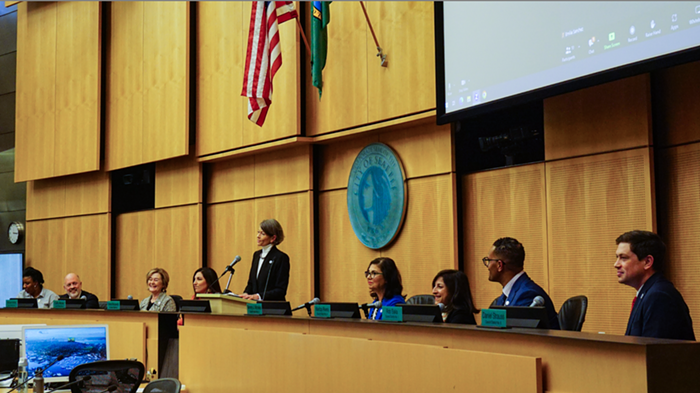Let's go back to the critics of Kshama Sawant. They were, if you remember, in the habit of describing her as divisive. What was meant by this? Just one thing: She totally represented the interests of the destitute and working poor. Sawant had nothing to offer the rich. Nothing. Why? Because they already have everything: political power, economic power, and power over the distribution of mainstream information. Today, the only member of our City Council who comes close to Sawant's political program and positions is Council Member Tammy Morales. She beat the Republican Tanya Woo by 2 points. This makes the district she represents—composed of "Rainier Beach, Beacon Hill, Columbia City, Hillman City, Othello, [and the like]"—the baddest ("...not bad meaning bad, but bad meaning good") part of town. And as one who lives in Columbia City, I can confirm there's great pride in this fact. A pride that grows as the majority of the Council regresses to the Lilliputian weltanschauung of Jonathan Choe and Brandi Kruse.
Let's make a quick visit to the city's official website. What do we find on the Seattle City Council page? This telling arrangement of headshots: Conservatives orbiting the one progressive, Morales. There is pro-private prisons Robert Kettle, Seattle Hospitality Group proxy Sara Nelson, progressive-turned-conservative opportunist Dan Strauss, the National Association of Realtors-purchased Tanya Woo, pro-NIMBY Joy Hollingsworth (not a single NIMBY bone was to be found in her socialist predecessor), corporate power-loving Cathy Moore (she recently lost her cool because she isn't nearly as cool Morales), labor-hating Maritza Rivera, and pro-cop Rob Saka.
Great visit last night at the Southwest Police Precinct Third Watch Roll Call, with Council President Sara Nelson @CMSaraNelson. A chance to express our support for our officers who serve and protect our community. Thank you, Precinct Captain Rivera and crew! @SeattlePD pic.twitter.com/u9uv0VOHQR
— Councilmember Rob Saka (@CMRobSaka) May 1, 2024
Morales, like that capital of my part of town, Columbia City, is at the center of what can only be described as super-negative Seattle—meaning, a Seattle that in the night and shadows of the pandemic exhumed and reanimated policies and programs that many thought were nothing but dust and bones. All of this is quite horrifying, to say the least. And it has about it the "funk of 40,000 years."
In 2012, the Australian Keynesian John Quiggin described the persistence of neoliberalism after the crash of 2008 as Zombie Economics. From this point on—the point when market fundamentalism lost, due to the massive bank bailout, its legitimacy—the living were shocked to find "dead ideas" walking among them. Something of the kind can be said about Seattle's post-pandemic City Hall. There is no better way to describe the idea of privatizing prisons than as a zombie with rotting teeth that chatter. The same chatter is heard in Nelson's and Rivera's attack on living wages.
Didn't get a chance to include this one in this morning's Fizz, but here's a mailer from District 6 Councilmember @CMDanStrauss declaring "DEFUND THE POLICE WAS A MISTAKE," listing pro-police votes, and allying Strauss with @MayorofSeattle and his efforts to hire more cops. /1 pic.twitter.com/lhcrRypKNG
— Erica C. Barnett ericacbarnett on all platforms (@ericacbarnett) July 14, 2023
Some members of the council also bring to mind a class of ghosts that haunted ancient Japan. Their trick was to look exactly like the living. But they were not flesh and bone. They were revealed to be (often when it was too late) just dry bones and rotting hair. (Watch Masaki Kobayashi's masterpiece Kwaidan to see how these ghosts haunted the young, peasants, and even blind musicians.) Fast-forward to 2023 and we see something screech-inducing happen to Dan Strauss: a transmogrification to appear alive in Ballard. Or how about Cathy Moore going from "[I'm] worried [my] three kids [won't] be able to afford to stay in the city they were raised in due to rapidly rising housing costs" to voting against Morales's initiative for developing affordable housing. From positive to negative; from the quick to the shades. Thank the stars that South Seattle is still represented by a council member who doesn't haunt us or have the putrefied ideas of a zombie.




















